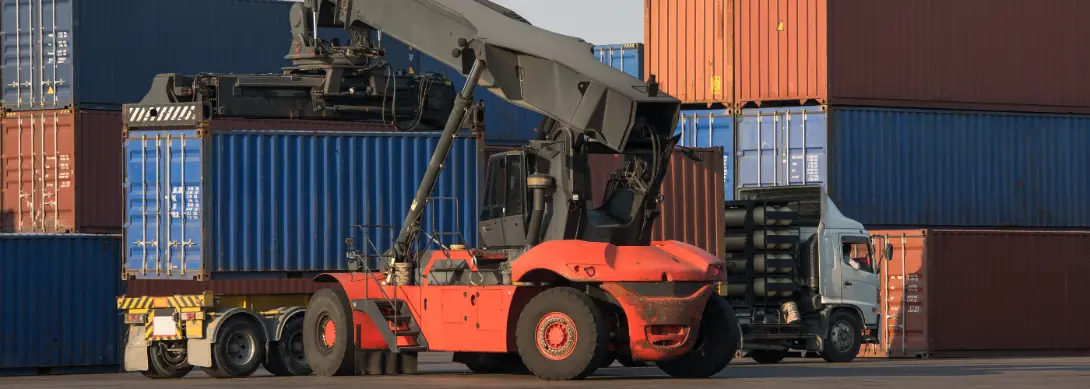حاوية شحن 20 قدم: دليل شامل

تُعد حاوية الشحن 20 قدم واحدة من أكثر الخيارات شيوعًا وتعددًا لنقل البضائع عالميًا. سواء كنت تنقل أغراضًا شخصية، بضائع تجارية، أو شحنات متخصصة، فإن فهم تفاصيل شحن الحاوية 20 قدم ضروري لتحقيق لوجستيات فعالة وبتكلفة مناسبة.
في هذا الدليل الشامل، سنستعرض كل ما تحتاج لمعرفته حول شحن حاوية 20 قدم، بما في ذلك المواصفات، التكاليف، طرق الشحن، ونصائح الخبراء للاستفادة القصوى منها.
ما هي حاوية الشحن 20 قدم؟
حاوية الشحن 20 قدم هي حاوية شحن فولاذية قياسية تُستخدم على نطاق واسع في التجارة العالمية. معروفة بمتانتها وتعدد استخداماتها، وهي مناسبة لنقل مجموعة متنوعة من البضائع عبر البحر، البر، أو السكك الحديدية.
المواصفات الرئيسية لحاوية 20 قدم
- الأبعاد الخارجية:
- الطول: 20 قدم (6.06 متر)
- العرض: 8 قدم (2.44 متر)
- الارتفاع: 8.5 قدم (2.59 متر)
- الأبعاد الداخلية:
- الطول: 19.4 قدم (5.9 متر)
- العرض: 7.7 قدم (2.35 متر)
- الارتفاع: 7.8 قدم (2.39 متر)
- السعة:
- الحجم: حوالي 33 متر مكعب (1,172 قدم مكعب).
- الحمولة: تصل إلى 28,000 كجم (61,729 رطل)، اعتمادًا على اللوائح ونوع الحاوية.
- المادة: مصنوعة من الفولاذ المقاوم للتآكل، مما يجعلها مناسبة للاستخدام طويل الأمد في مختلف الظروف المناخية.
نصيحة احترافية: حاوية 20 قدم مثالية للشحنات الصغيرة إلى المتوسطة، حيث توفر مساحة واسعة وتعتبر أكثر تكلفة من الخيارات الأكبر حجمًا.
الاستخدامات الشائعة لحاويات 20 قدم
- النقل الشخصي: مثالية لنقل الأثاث، الأغراض المنزلية، والممتلكات الشخصية.
- الشحنات التجارية: مناسبة لنقل الآلات، الإلكترونيات، الأقمشة، وغيرها من البضائع.
- البضائع المبردة: متوفرة بنسخ مبردة (reefer) للأغراض القابلة للتلف.
- مواد البناء: تُستخدم بشكل متكرر لنقل المواد الثقيلة مثل الفولاذ، الأسمنت، أو الأخشاب.
- شحن المركبات: يمكنها استيعاب المركبات الصغيرة، الدراجات النارية، أو أجزاء السيارات المفككة.
طرق الشحن لحاويات 20 قدم
الشحن البحري
- الطريقة الأكثر شيوعًا وتكلفة مناسبة للشحنات الدولية.
- الخيارات تشمل:
- حمولة الحاوية الكاملة (FCL): يتم حجز الحاوية بالكامل لبضائعك، مما يوفر الأمان والكفاءة.
- أقل من حمولة الحاوية (LCL): تشارك شحنتك مساحة الحاوية مع شحنات أخرى، مما يقلل التكاليف للشحنات الأصغر.
الشحن البري
- مثالي للشحنات المحلية أو عبر الحدود لمسافات أقصر.
- تُنقل عادة عبر شاحنات مجهزة للتعامل مع أحجام الحاويات.
الشحن بالسكك الحديدية
- مناسب للنقل البري لمسافات طويلة في المناطق التي تمتلك شبكات سكك حديدية قوية.
- يُستخدم غالبًا بالتزامن مع الشحن البحري لحلول الشحن متعددة الوسائط.
نصيحة احترافية: اختر FCL لاستخدام الحاوية بالكامل و LCL للشحنات الأصغر لتوفير التكاليف.
تكلفة شحن حاوية 20 قدم
تختلف تكاليف الشحن بناءً على عوامل مثل المسافة، طريقة الشحن، وطبيعة البضائع. إليك تفصيل عام:
- الشحن البحري (FCL): 2,000–4,000 دولار أمريكي للطرق الدولية.
- الشحن البحري (LCL): 100–300 دولار أمريكي لكل متر مكعب للمساحة المشتركة.
- الشحن البري: 500–1,500 دولار أمريكي للشحنات المحلية أو القصيرة عبر الحدود.
- التكاليف الإضافية: رسوم المناولة في الموانئ، رسوم التخليص الجمركي، التأمين، والنقل الداخلي.
نصيحة احترافية: اطلب عروض أسعار متعددة من شركات الشحن لمقارنة الأسعار والخدمات.
كيفية الاستعداد لشحن حاوية 20 قدم
اختيار النوع المناسب من حاوية 20 قدم
- قياسية: مناسبة للبضائع العامة مثل الصناديق، والمنصات النقالة، أو الصناديق الخشبية.
- مبردة (Reefer): تُستخدم للبضائع القابلة للتلف التي تحتاج إلى التحكم في درجة الحرارة.
- مبردة (Reefer): تُستخدم للبضائع القابلة للتلف التي تحتاج إلى التحكم في درجة الحرارة.
التعبئة والتحميل بكفاءة
- استغل المساحة بأقصى درجة من خلال تكديس العناصر بعناية وتأمينها باستخدام الأشرطة.
- فك الأثاث أو العناصر الكبيرة لتوفير المساحة.
- استخدم مواد الحماية مثل لفائف الفقاعات، والمنصات النقالة، والصناديق لتجنب التلف.
استكمال الوثائق
- جهز بوليصة الشحن، قائمة التعبئة، الفاتورة التجارية، وأي مستندات مطلوبة أخرى.
- تأكد من استيفاء متطلبات التخليص الجمركي للشحنات الدولية.
مزايا شحن حاوية 20 قدم
- فعالة من حيث التكلفة: توفر قيمة ممتازة للشحنات الصغيرة إلى المتوسطة الحجم.
- متعددة الاستخدامات: مناسبة لنقل مجموعة واسعة من البضائع، من الأغراض الشخصية إلى المعدات الثقيلة.
- متينة: مصممة لتحمل الظروف الجوية القاسية والمناولة الخشنة.
- معيار عالمي: معتمدة على نطاق واسع من قبل شركات الشحن والموانئ حول العالم.
- قابلة للتوسع: مرنة لتلبية احتياجات الشحن الكاملة (FCL) أو الجزئية (LCL).
التحديات وكيفية التغلب عليها
قيود المساحة
- قد لا تستوعب حاوية 20 قدم الشحنات الكبيرة أو ذات الحجم الكبير.
الحل: اعمل مع وسيط جمركي لضمان الامتثال للوائح.
التأخيرات الجمركية
الوثائق غير الصحيحة قد تؤدي إلى تأخيرات أو رسوم إضافية.
الحل: استعِن بمحترفين في التعبئة والتحميل لضمان المناولة الآمنة.
التحميل والتفريغ
التحميل غير الصحيح قد يؤدي إلى تلف أثناء النقل.
Solution: Hire professional packers and loaders for secure handling.
نصائح لشحن حاوية 20 قدم بسلاسة
- خطط مسبقًا: احجز شحنتك مبكرًا لتأمين أفضل الأسعار وتوافر الحاويات.
- اعمل مع شركات شحن موثوقة: اختر مزودي خدمات يتمتعون بسجل حافل في شحن الحاويات.
- استثمر في التأمين: احمِ بضائعك من الخسائر أو الأضرار المحتملة.
- استخدم أدوات التتبع: تابع تقدم شحنتك باستخدام أدوات التتبع في الوقت الفعلي.
- افحص الحاوية: تأكد من أن الحاوية بحالة جيدة قبل تحميل بضائعك.
الأسئلة الشائعة حول شحن حاوية 20 قدم
- كم تستطيع حاوية 20 قدم أن تحمل؟
يمكن أن تحمل حاوية 20 قدم ما يصل إلى 33 متر مكعب (1,172 قدم مكعب) من البضائع، بحد أقصى للحمولة 28,000 كجم (61,729 رطل). - ما تكلفة شحن حاوية 20 قدم؟
تتراوح التكاليف بين 2,000–4,000 دولار أمريكي للشحن الدولي الكامل (FCL)، حسب المسار وعوامل أخرى. - هل يمكنني شحن البضائع المبردة في حاوية 20 قدم؟
نعم، تتوفر حاويات مبردة (Reefer) 20 قدم للبضائع الحساسة للحرارة. - ما الوثائق المطلوبة لشحن حاوية 20 قدم؟
تشمل الوثائق الأساسية بوليصة الشحن، الفاتورة التجارية، قائمة التعبئة، ونماذج التخليص الجمركي. - هل التأمين ضروري لشحن الحاويات؟
رغم أنه ليس إلزاميًا، فإن التأمين موصى به بشدة لحماية بضائعك من المخاطر المحتملة.